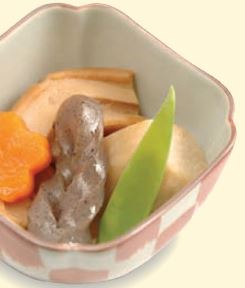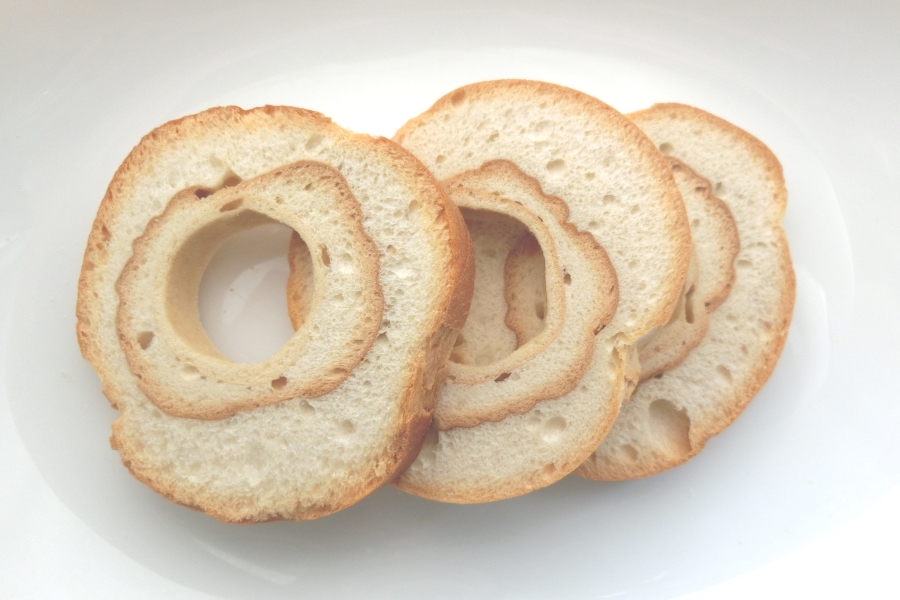Contents:
- Fascinating Facts About Fu
- History of Fu
- A Variety of Fu
- Enhance The Flavor of Your Everday Dishes!
- Eat Fu to Stay Healthy
- Fu Recipes
- Dashimaki Tamago (Japanese Rolled Omlete) Recipe
- Kuruma-fu no Nimono (Simmered Kuruma-fu Dish) Recipe
- Fu Chanple (Stir-fried fu) Recipe
Fascinating Facts About Fu
Fu is not bread, nor is it a cracker. It isn’t a snack food, nor is it a staple food. Although it is made from wheat flour, you don’t see fu in the flour-consuming nations of Europe or North America. Fu is a uniquely Japanese specialty. Just like koyadofu (freeze-dried tofu), miso (fermented soybean paste), katsuo-bushi (dried fish flakes), niboshi jako (dried tiny fish), sushi and soba (buckwheat noodles), there is nothing like it anywhere else in the world. Fu is spongy, soft to the bite, and doesn’t have much flavor or weight. In fact, it was nearly forgotten, even in Japan. However, in recent years fu has drawn attention again because, being made from flour gluten, it’s an excellent protein food containing zero fat and an abundance of wheat nutrients. Fu is great to include in the diet since it helps manage one’s weight and health. It also becomes delicious when prepared as a dish, which is easy to do. For these reasons fu has made a big comeback, which has revitalized long-established fu stores throughout Japan. Moreover, because fu doesn’t have much flavor, it blends well with other ingredients. Many delicious fu recipes have been created for ultimate Japanese cuisine like kaiseki-ryori and shojin-ryori. Now fu is becoming more popular than ever!
History of Fu
The history of Ju dates back to the Muromachi period, when it was eaten by monks and imperial courtiers. Legend says that Sen no Rikyu, who had established the Japanese tea ceremony during the Azuchi Momoyama period, served roasted namafu (raw wheat gluten) seasoned with miso (soybean paste) and sugar for a tea ceremony, which had then become popular as “fu no yaki (roasted fu).” In the Edo period fu was popularized for its delicious flavor and high nutritional value. It became an indispensable ingredient as a good source of protein since protein-rich foods were scarce at that time. Fu was loaded onto kitamae-bune (cargo ships), the major means of distribution at the time, and soon its use spread nationwide. Not just in Kyoto, but everywhere from Hokkaido in the north to Okinawa in the south, you can find local specialty fu products and fu dishes. Even in the remote countryside, there are many long-established fu stores that have been in existence for a hundred or even two hundred years.
A Variety of Fu
Fu is solidified wheat gluten (protein). To begin with, wheat flour is divided into hard flour and soft flour. The outer layer of the wheat kernel is rich in gluten and is milled into hard flour, which becomes sticky when kneaded. The inner portion of the wheat kernel, which doesn’t contain much gluten, is milled into soft flour. Soft flour doesn’t become sticky when kneaded, and therefore it is suitable for use in tempura, cakes okonomi-yaki (Japanese-style pancakes) and other foods. To make fu, you first knead the hard flour with water which forms a dough, then allow it to rest. After this you wash out the starch, what’s left of the dough is wheat-protein gluten, the primary ingredient in fu. Add glutinous rice to this and steam or boil it, and you will have nama-fu (raw-fu). Some of the types of nama-fu are yomogi-fu, awa-fu, goma-fu and saikuju. One method of preparation to add flour to the gluten, knead it well and roast it until a toasty aroma is released.
Once this has dried you will have yaki-fu (roasted-fa). The varieties of yaki-fu include komachi-fu, anpei-fu, matsutake-fu and temari-fu. When the dough is wrapped around a pole and roasted, it is called kuruma-fu. Incidentally, the type of fu most readily available in America is yaki-fu. Fu exhibits many regional characteristics and has countless types and names. When made by a skilled fu maker with quality ingredients and water, fu’s wonderful flavor is brought out. The following types of fu have these local haracteristics: wheelshaped kuruma-fu in the Hokuriku and Tohoku regions; koppepan bread-shaped anpei-fu in Yamaguchi Prefecture; hanbeifu served by a long-established fu restaurant in Kyoto; age-Ju; fu-gashi; the Okinawa specialty fu exclusively for stirfrying; matsutake mushroom-flavored matsutake-fu; and sukiyaki-Ju exclusively for use in sukiyaki.
Enhance The Flavor of Your Everday Dishes!
Compared to bread crumbs, the holes in the surface of fu are smaller, which means that fu has a higher rate of water absorption and greater moisture retention. In fact, fu’s water-retention ability is 1.5 times higher than that of bread crumbs. Also, fu has a smooth texture because the gluten particles are small. By exploiting these characteristics,
fu can be used for a variety of dishes. Fu is routinely used in sumashi-jiru (clear soup) and miso soup, but you can also substitute bread crumbs with fu to make hamburgers. Fu will help keep meat juicy and give it a smoother texture. Add fu to iwashi-tsumire (minced fish) and dashimaki tamago (Japanese rolled omelet), and these foods will become even more delicious by absorbing plenty of dashi stock. You can even use fu in cakes, pudding, okonomi-yaki (Japanese-style pancakes) and tako-yaki (octopus balls) making them unbelievably delectable and juicy.
Eat Fu to Stay Healthy
Fu might not appear very nutritious, but in fact it has many health-benefiting properties. Because fu is a good protein, it’s an ideal food for enhancing your beauty and helping to control your weight. Additionally, you can expect even more beneficial results by combining fu with other foods. When combined with eggs, for example, it helps in the elimination of neutral fat and cholesterol present in the blood. If eaten with carbohydrates such as rice or noodles, wheat albumin mitigates the rapid rise of blood sugar and helps burn carbohydrates, thus preventing obesity and the onset of diabetes. Combining fu with cooking oil helps prevent infectious diseases. Combining fu with fish or meat containing vitamin B helps prevent the loss of DHA and EPA, which keeps our skin beautiful. We encourage you to rediscover the power and delicious flavor of this traditional Japanese ingredient, and to learn more about it. Let’s use nutritious fu more often!
How to Cook Fu
Dashimaki Tamago (Japanese Rolled Omlete) Recipe
Your omelet becomes smoother in texture, juicier, healthier and doubled in size!

Ingredients (Serves 2)
- 3 eggs
- 0.3 oz. yaki-fu
- 100 ml dashi soup stock (We use “Nijiya Tsuyu Tennen,” a soup base, diluted with 5 times the amount of water.)
Cooking Directions
- Steam awabi steeped in Japanese sake.
*Don’t steam awabi for over 15 mins (appropriate time is 10 to 15 mins) - In a plastic bag, crush the yaki-fu to a powder. Combine it with beaten eggs and dashi stock.
- Cook the egg mixture in a rectangular omelet pan in the same way you cook a regular rolled omelet.
Kuruma-fu no Nimono (simmered kuruma-fu dish) Recipe
Add Seasonal Vegetables for Your Own Delicious Masterpiece!

Ingredients (Serves 2)
- 1 oz. kuruma-fu
- 200 ml dashi soup stock (We use “Nijiya Tsuyu Tennen,” a soup base, dilluted with 5 times the amount of water)
- Add seasonal vegetables of your choice, such as carrots, sayaendo (peas in the pod), satoimo (Japanese taro). etc.
- Konnyaku (a jelly-like food made from konnyaku potatoes)
- Kaiware daikon (Japanese radish sprouts) for garnish
- Mitsuba (Japanese wild parsley) for garnish
Cooking Directions
- Soak the kuruma-fu in water until it becomes soft.
- Simmer the dashi stock and add the vegetables. Add whitefish or c hic ken if desired.
- Squeeze the excess water from the fu, and cut it into pieces of adequate size. Add to the simmering vegetables.
- Turn off the heat. Scoop into a serving bowl, then garnish with kaiware daikon and mitsuba.
Fu Chanple (Stir-fried fu) Recipe
A quick-and-easy Okinawa-style recipe

Ingredients (Serves 2)
- 1.5 oz. Kuruma-fu
- 1 egg
- 1/4 block momen-dofu (cotton-strained, firm tofu)
- 200 ml dashi soup stock (We use “Nijiya Tsuyu Tennen,” a soup base. diluted with 5 times the amount of water)
- Miso
- Cooking oil
- Chopped green onions (for garnish)
Cooking Directions
- Heat the dashi stock in a pot. Soak the fu in the soup until it is soft. Let it cool, and gently squeeze out the excess water.
- Heat the oil in a pan. Cut the tofu and fu into pieces of adequate size. and stir-fry in the pan.
- Season to taste with miso, then pour in beaten egg. Cook until the egg is somewhat solid.
- Garnish with green onions If desired. A wide variety of fu products are available at Nijiya Market. Fu is ideal for sukiyaki, osuimono (clear broth) and miso soup along with many other rec ipes. Try the healthy fu recipes from Gochiso magazine!

